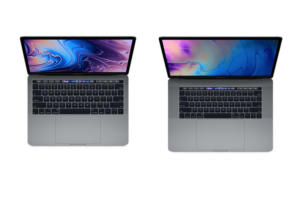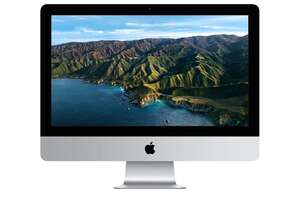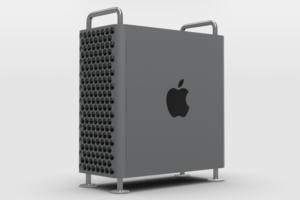Which MacBook, MacBook Pro, MacBook Air, iMac, iMac Pro, Mac mini, or Mac Pro should you buy?
[ad_1]
If you’re reading this article, chances are you’re thinking about buying a new Mac and may be in need of a little guidance. Fortunately, we’re quite familiar with Apple’s family of Macs, and we’re happy to help you choose the right Mac for you. This buying guide provides an overview of all the Mac models available, with specs, reviews, release dates, and reviews. So get your wallet ready and let us help you pick your perfect Mac.
MacBook Air
Models for sale were originally released November 2020.
What is it? The MacBook Air is Apple’s most affordable laptop. Apple currently offers two 13-inch models.
Who’s it for? The MacBook Air is ideal for the budget conscious. It’s also for anyone who is always on the go, doesn’t want to be bogged down by a regular-size laptop, and needs a computer that’s more versatile than an iPad.
What are the specifications? The two MacBook Air models have Apple’s M1 system on a chip (SoC), which features an 8-core CPU, 16-core Neural Engine, and 8GB of RAM (upgradable to 16GB). Apple claims 15 hours of battery life for wireless web and 18 hours of Apple TV app movie playback.
The main difference between the models offered is the GPU (graphics processing unit) and file storage. The $999 model has a 7-core GPU and a 256GB SSD, while the $1,249 model has an 8-core GPU and a 512GB SSD.
How do I connect stuff? The MacBook Air has only a pair of Thunderbolt/USB 4 connectors. If you want to connect USB-A devices, you need either a USB-C to USB adapter, like Apple’s $19 one, or a USB-C hub that has USB-A ports.
The MacBook Air has built-in Wi-Fi for connecting to a network. It also provides built-in Bluetooth for wirelessly connecting a mouse or other peripherals. If you want to connect to an ethernet network, you need an adapter.
How fast is it? The M1 provides performance that is leaps and bounds faster than what was previously found in the MacBook Air. It’s plenty fast enough for general purpose use—it’s actually close to performing like the 13-inch M1 MacBook Pro in this situation. But because it doesn’t have a fan to keep the computer cool, it may throttle down its speed during long processing sessions, such as video editing or compiling code. Even then, it’s still plenty fast.
Macworld’s buying advice: The MacBook Air is a great affordable laptop for someone who does general-purpose work and moves around a lot, such as a student or a self-employed person. You can’t easily upgrade the storage or memory after purchase, so you should buy the model with the largest amount of storage you can afford.
Review our review of the $1,249 MacBook Air
Apple is reportedly working on a new MacBook or MacBook Air that could release later this year or early in 2021, but you won’t be upset with the current MacBook Air—it’s a great machine at a great price.
Ready to buy a MacBook Air? Go to the Apple Store
MacBook Pro
M1-based 13-inch models were released November 2020. Intel-based 13-inch models were released May 2020. 16-inch models released November 2019.
What is it? The MacBook Pro is Apple’s high-performance laptop.
Who’s it for? The MacBook Pro is for the demanding user who wants a portable computer that also performs well.
What are the specifications? The MacBook Pro is available in screen sizes of 13 inches and 16 inches. All laptops include the Touch Bar interface at the top of the keyboard.
Apple offers four 13-inch models:
- $1,299 model: Apple 8-core M1 SoC with 8GB of memory, an 8-core GPU, and a 16-core Neural Engine; 256GB SSD, two Thunderbolt/USB 4 ports
- $1,499 model: Apple 8-core M1 SoC with 8GB of memory, an 8-core GPU, and a 16-core Neural Engine; 512GB SSD, two Thunderbolt/USB 4 ports
- $1,799 model: 2.0GHz quad-core Intel Core i5 (10th generation) processor, 16GB of memory, Intel Iris Plus Graphics integrated graphics, 512GB SSD, four Thunderbolt 3 ports
- $1,999 model: 2.0GHz quad-core Intel Core i5 (10th generation) processor, 16GB of memory, Intel Iris Plus Graphics integrated graphics, 1TB SSD, four Thunderbolt 3 ports
The 13-inch Retina display has a native resolution of 2560×1600, and macOS offers a scaled resolution up to 1680×1050.
Apple has two 16-inch models:
- $2,399 model: 2.6GHz 6-core Intel Core i7 (9th generation) processor, 16GB of memory, 512GB SSD, Intel UHD Graphics 630 integrated graphics, 4GB Radeon Pro 5300M discrete graphics, four Thunderbolt 3 ports
- $2,799 model: 2.3GHz 8-core Intel Core i7 (9th generation) processor, 16GB of memory, 1TB SSD, Intel UHD Graphics 630 integrated graphics, 4GB Radeon Pro 5500M discrete graphics, four Thunderbolt 3 ports
The 16-inch Retina display has a native resolution of 3072×1920, and macOS’s highest scaled resolution on those laptops is 2048×1280.
What is the Touch Bar? The Touch Bar is a input device that sits on top of the keyboard. It’s basically a narrow touchscreen. The buttons and controls available on the Touch Bar change depending on the software you are using. Learn more about the Touch Bar.
How do I connect stuff? No need to worry about wireless connectivity: the MacBook Pro has Wi-Fi and Bluetooth.
It’s the wired connectivity you need to be concerned with. The MacBook Pro has only Thunderbolt 3 ports, which are compatible with USB-C. The $1,299 and $1,499 13-inch MacBook Pro models have two ports, while every other MacBook model has four.
If you have a Thunderbolt 3 device, you can plug it directly into the laptop. The same goes for any USB-C device. However, if you have wired devices that aren’t USB-C or Thunderbolt 3, you’ll need an adapter. We have a separate MacBook Pro Thunderbolt adapter guide to help you decide which ones you’ll need. Unfortunately, be prepared to shell out a good amount of extra cash.
How fast is it? The MacBook Pro models are, to no surprise, the fastest Apple laptops. If it’s processing power you seek, it’s the MacBook Pro you want.
There is a thing you need to consider regarding the MacBook Pro. In November 2020, Apple updated the $1,299 and $1,499 models with its own M1 SoC, replacing the Intel processors used previously. The M1 is fast—the two M1 laptops are actually faster than the $1,799 and $1,999 Intel-based models, and in some situations, it’s faster than the 16-inch MacBook Pro.
Macworld’s buying advice: For the most demanding mobile Mac user—someone whose work requires a lot of processing power—the MacBook Pro is the ticket. However, the MacBook Pro is in a transition period because of Apple’s switch from Intel processors to its own SoC. As of this writing, only two of the six different models are available with Apple’s M1. And the M1 outperforms the other MacBook Pro models.
If speed is your priority over everything else—port connectivity and screen size aren’t serious considerations—get a $1,299 or $1,499 13-inch MacBook Pro with Apple’s M1 SoC. If you want speed, but also want more ports, consider the $1,799 13-inch MacBook Pro or the 16-inch Macbook Pro. They’re still fast and they offer more ports than the M1 models. However, Apple will likely be releasing a new 16-inch model later this year, so if you can wait, the wait will pay off. You’ll get a really fast laptop.
If your work mostly involves web surfing and other productivity tasks, however, go for a MacBook Air.
Ready to buy a MacBook Pro? Go to the Apple Store
Mac mini
Models for sale were originally released November 2020.
What is it? The Mac mini is Apple’s smallest desktop Mac. It’s a nice combination of speed and affordability. It’s not only fast enough for general-purpose use, but its multi-core speed is quite good—if you use a professional app like a video editor, 3D software, or developer tools, the Mac mini can handle it, no problem.
Who’s it for? Because of its price and performance, the Mac mini is a great Mac for just about anybody. It makes for an ideal primary Mac for a home or small office. Professionals on a budget will be satisfied with the Mac mini. If you’re switching from a PC, you can use your PC’s keyboard and mouse with the Mac mini. The Mac mini is also ideal as a secondary Mac in your home, and it can integrate into your home entertainment center.
What are the specifications? Apple sells three Mac mini models:
- $699 model: Apple 8-core M1 SoC with 8GB of memory, an 8-core GPU, and a 16-core Neural Engine; 256GB SSD
- $899 model: Apple 8-core M1 SoC with 8GB of memory, an 8-core GPU, and a 16-core Neural Engine; 512GB SSD
- $1,099 model: 3.0Hz 6-core Intel Core i5 (8th generation) CPU, 8GB of memory, integrated Intel UHD Graphics 630 GPU, 512GB SSD.
The Mac mini does not include a display, keyboard, or mouse, so you’ll have to provide your own, or you can customize your order to include these devices as extra-cost options.
Since the Mac mini lacks an optical drive, you need to buy an external USB optical drive if you want to read or burn CDs and DVDs.
How do I connect stuff? Like Apple’s other Macs, the Mac mini has Wi-Fi and Bluetooth. The $699 and $899 M1-based Mac minis have two Thunderbolt/USB 4 ports, while the $1,099 Intel-based Mac mini has four Thunderbolt 3/USB-C ports. All Mac minis have two USB-A ports, an HDMI 2.0 port, a headphone jack, and a gigabit ethernet port.
To connect a display, you can use the HDMI port or a Thunderbolt port. You might have to buy an adapter if your display doesn’t have either HDMI or a port that can connect to Thunderbolt.
How fast is it? The $699 and $899 M1-based Mac minis are very fast. In fact, they are as fast as the 13-inch M1 MacBook Pro. As of this writing, the $699 M1 Mac mini gives you the best performance for the price of any Mac that Apple offers. It’s impressive.
The $1,099 Intel-based Mac mini offers good speed, but it’s not as fast as the M1 models. The Intel model is the only one that allows you to install 32GB or 64GB of RAM, so if you do heavy production work, it might be a better fit for you.
Macworld’s buying advice: Apple is rumored to be releasing a high-end model with Apple silicon later this year, but the current entry level Mac mini is an excellent machine for most Mac users—new or experienced, professional or general consumer. For you’re on a budget or not, it’s a great choice, especially if you already have a spare keyboard, mouse, and display. Read our review of the $699 Mac mini.
Ready to buy a Mac mini? Go to the Apple Store
21.5-inch iMac
Model for sale originally released in June 2017.
What is it? The iMac is Apple’s iconic all-in-one computer. Made of aluminum, the iMac has a built-in display and looks stately as it sits on a desk.
Who’s it for? The iMac is great for both novices and demanding users. It can handle general-purpose and heavy-duty tasks equally well. It’s ideal for someone who needs to buy a complete computer setup (keyboard, mouse or trackpad, and display) and wants to maximize workspace efficiency.
What are the specifications? This Mac model is currently available with a 21.5-inch 1920×1080-resolution display. It has a 7th-generation 2.3GHz dual‑core Intel Core i5 processor, Intel Iris Plus Graphics 640 integrated graphics, and a 256GB SSD.
You can’t upgrade the 21.5-inch iMac yourself after you buy it, so consider paying an extra $200 at the outset for a memory upgrade to 16GB. If you want to add more RAM later, you need to bring the iMac to an Apple store. The 21.5-inch iMac also offers a 1TB Fusion Drive upgrade for no additional cost, but the Fusion Drive is slower than the 256GB SSD.
The iMac comes with Apple’s Magic Keyboard and Magic Mouse 2. If you order online from the Apple Store, however, you can switch the keyboard to a version with a numeric keypad, and/or switch the mouse to a Magic Trackpad 2. You can opt to get both a Magic Mouse 2 and a Magic Trackpad 2 for $129 extra.
The iMac does not have an optical drive. If you want to read or burn CDs and DVDs, you need to buy an external USB optical drive.
How do I connect stuff? Wi-Fi and Bluetooth are built-in. The 21.5-inch iMac has four USB 3.0 ports, two Thunderbolt 3 ports, a gigabit ethernet port, and an SDXC card slot.
How fast is it? iMacs are among Apple’s fastest computers, however, the $1,099 iMac is Apple’s slowest iMac. Also, if you upgrade to a Fusion Drive, you get a significant amount of storage (1TB), but a Fusion Drive isn’t as fast as an SSD.
Macworld’s buying advice: For new Mac owners, the $1,099 iMac is an alternative to the Mac mini to consider, but the iMac isn’t as fast as the Mac mini and it’s also several years old. If you want an all-in-one, we recommend looking at the 24-inch iMac (below) for a little more. However, if you opt for the 21.5-inch iMac, spending more for a RAM upgrade at the point of purchase could help you avoid some hassle in the future.
Ready to buy an iMac (with standard display)? Go to the Apple Store
24-inch iMac
Model for sale originally released in April 2021.
What is it? Apple unveiled the 24-inch iMac at its Spring Loaded event in April 2021. It’s a fresh new take on the iMac and the first update in more than a decade, with a cleaner design, Apple silicon, and a choice of colors.
Who’s it for? The iMac is great for both novices and demanding users. It can handle general-purpose and heavy-duty tasks equally well. It’s ideal for someone who needs to buy a complete computer setup (keyboard, mouse or trackpad, and display) and wants to maximize workspace efficiency.
What are the specifications? The 24-inch iMac uses Apple’s M1 chip rather than Intel’s processors, and there are several configurations available:
- $1,299: Apple M1 SoC with an 8-core CPU (4 performance cores, 4 efficiency cores), 16-core Neural Engine, and 7-core graphics processor (GPU); 8GB of memory; 256GB SSD
- $1,499: Apple M1 SoC with an 8-core CPU (4 performance cores, 4 efficiency cores), 16-core Neural Engine, and 8-core graphics processor (GPU); 8GB of memory; 256GB SSD
- $1,699: Apple M1 SoC with an 8-core CPU (4 performance cores, 4 efficiency cores), 16-core Neural Engine, and 8-core graphics processor (GPU); 8GB of memory; 512GB SSD
The 24-inch iMac 24 can have a maximum of 16GB of memory, and you can also upgrade to a 512GB SSD in the $1,299 and $1,499 models. These upgrades cost extra and can’t be upgraded after purchase.
The 24-inch 4.5K Retina display has 11.3 million pixels and support for the P3 wide color gamut, over a billion colors, 500 nits of brightness, and True Tone. Apple treats the display with an anti-reflective coating to help with readability.
Why does it look different from the other iMacs? The 24-inch iMac has a much different design than the 21.5-inch and 27-inch models. The bezels around the display are much smaller than on the other iMacs, but it still has a “chin,” a section located below the display that houses the iMac’s internals. The chin doesn’t have the Apple logo on the front. Instead, it’s on the back. Most notably, the 24-inch iMac comes in several colors: the $1, 299 model is available in blue, green, pink, and silver, while the $1,499 and $1,699 models are available in the same colors as well as orange, purple, and yellow.
How do I connect stuff? The $1,299 24-inch iMac 24 has two Thunderbolt 3 ports that also work with USB-C devices. The $1,499 and $1,699 iMacs have two additional USB-C ports. If you have a USB-A device, you need to buy an adapter, such as Apple’s USB-C to USB Adapter ($19). If you have multiple USB-A devices and other items, consider a Thunderbolt hub. The 24-inch iMac also has a headphone jack on the side.
The 24-inch iMac, unlike the older iMacs, does not have an SDXC slot. Once again, you’ll need an adapter, such as the Anker SD Card reader ($17). However, it does have a super-cool magnetic power cord.
Wi-Fi 6 and Bluetooth 5.0 are built-in. Apple doesn’t put a gigabit ethernet port on the 24-inch iMac—instead, it’s on the power adapter. But that ethernet-equipped power adapter comes standard with the $1,499 and $1,699 models. It’s not included with the $1,299 model, but you can select it as an option at the point of purchase—and yes, that means you’ll have to pay extra for it.
How fast is it?: Since the 24-inch iMac has the same M1 as the Mac mini, it’s speed is very similar. That means it’s fast, and it’s faster than the 21.5-inch models it replaces. It’s got all the speed general consumers need, and it can handle pro applications, no problem. However, the $1,299 model has only one fan inside its body, while the $1,499 and $1,699 models have two fans. That means the high-priced models do a better job keeping its internals cool. The $1,299 model may need to slow down its performance on heavy-duty tasks in order to maintain a proper temperature.
Macworld’s buying advice: Everything about the iMac is greatly improved, from the design to the display to its performance. We think the sweet spot is the $1,499 model, which gets you more ports, Touch ID, and ethernet, but if you don’t need those things the $1,299 model will be plenty good.
Ready to buy a 24-inch iMac 24? Go to the Apple Store
27-inch iMac
Model for sale originally released in August 2020.
What is it? The 27-inch iMac is Apple’s high-end all-in-one Mac. Made of aluminum, the iMac has a built-in display and looks stately as it sits on a desk. It also offers top-notch performance.
Who’s it for? The 27-inch iMac is designed for professionals who work with high-resolution videos, photos, or images. Or it’s for the demanding user who wants the best image quality for everyday use.
What are the specifications? Apple’s 27-inch iMac come with a 5120×2880-resolution Retina display. Apple offers three models. More details:
- $1,699 27-inch model: 3.1GHz 6‑core Intel Core i5 processor, 8GB of RAM, 4GB Radeon Pro 5300 graphics, and 256GB SSD
- $1,899 27-inch model: 3.3GHz 6‑core Intel Core i5 processor, 8GB of RAM, 4GB Radeon Pro 5300 graphics, and a 512GB SSD
- $2,099 27-inch model: 3.8GHz 8‑core Intel Core i7 processor, 8GB of RAM, 8GB Radeon Pro 5500 XT graphics. and a 512GB SSD
Users can upgrade the RAM on the 27-inch iMac easily. The machine has four RAM slots, accessible through the back. Apple installs the standard 8GB as a pair of 4GB memory modules, so you can add more RAM after you buy the system. Or if you prefer, you can upgrade the RAM at the point of purchase.
The 27-inch iMacs have the option of standard glass or nano-texture glass ($270) in front of the display. The standard glass is glossy, while the nano-texture glass has a matte-like finish that produces less glare.
How do I connect stuff? Wi-Fi and Bluetooth are built-in. All Retina iMacs have four USB 3.0 ports, two Thunderbolt 3 ports, a gigabit ethernet port, and an SDXC card slot.
How fast is it? The 27-inch iMac is among Apple’s fastest computers when it comes to single-core performance. When it comes to multi-core speed, the Mac Pros are faster machines, but the iMacs with 6-core processors have closed the gap. You can improve the multi-core performance by opting for the 3.6GHz 10-core Core i9 upgrade in the 27-inch $1,899 and $2,099 models. You’ll pay more, but it may be worth it to your for the performance boost.
Macworld’s buying advice: The allure of the 27-inch iMac is strong; you’ll love the way it looks. You may not love the way the price looks, however. If you are hesitant about the price, it won’t take long to get over it, once you’ve used the iMac for a couple of weeks.
Ready to buy an iMac with Retina display? Go to the Apple Store
Mac Pro
Model currently for sale originally released December 2019.
What is it? The Mac Pro is Apple’s workstation. It’s designed for professionals who need a powerful and flexible machine.
Who’s it for? The Mac Pro is ideal for professionals who work with applications that use as many processing cores as possible—video-editing applications, image-editing software, 3D programs, audio editing, software developers, and the like.
What are the specifications? Apple doesn’t offer standard configurations of the Mac Pro. You start with a base model and custom configure it to your liking. Here’s a overview of the major specifications.
Processor: The Mac Pro uses Intel Xeon W processors. You can choose an 8- 12-, 16-, 24-, or 28-core CPU.
Memory: The Mac Pro uses DDR4 ECC memory, and has 12 DIMM slots. However, the memory configurations that Apple offers don’t always fill all of the slots. The amount of memory you can opt for starts at 32GB (four 8GB DIMMs) and goes all the way up to 768GB (six 128GB DIMMs or 12 64GB DIMMs). If you get a 24- or 28-core processor, you can get up to 1.5TB of memory, which fills all 12 DIMM slots.
Graphics: The Mac Pro has room for two graphics cards. Apple has three different AMD cards from which to choose: an 8GB AMD Radeon Pro 580X, a 32GB AMD Radeon Pro Vega II, or the 64GB AMD Radeon Pro Vega II Duo. Apple will be offering soon a 16GB Radeon Pro W5700X, and a 32GB Radeon Pro W5700X Duo.
Storage: The Mac Pro has room for two SSD modules. You can get a single 256GB SSD, or you can get 1TB, 2TB, or 4TB of storage that’s installed as a pair of SSDs. An 8TB storage option will be available soon.
Afterburner: Apple offers a special optional component with the Mac Pro called Afterburner. This is an accelerator card with a Field-programmable Gate Array (FPGA) designed for video production. According to Apple, Afterburner can handle up to six streams of 8K ProRes RAW video at 30 fps; up to 23 streams of 4K ProRes RAW video at 30 fps; and up to 16 streams of 4K ProRes 422 video at 30 fps.
How do I connect stuff? To connect external devices, the Mac Pro has two USB 3 ports and two Thunderbolt 3 ports on the back of the machine. The top of the Mac Pro has two Thunderbolt 3 ports.
Inside the Mac Pro, there are 8 PCI Express expansion slots. You can install up to two MPX modules, or up to four PCI Express cards. There is also three full-length PCI Express gen 3 slots (one x16 slot and two x8 slots).
Wi-Fi and Bluetooth come built-in on the new Mac Pro. The back of the machine also has two 10Gb ethernet jacks.
How fast is it? Apple says that the new Mac Pro is a “designed in pursuit of performance,” capable of handling 8K video editing, 3D applications, software development, and other production-oriented tasks.
Apple’s Mac Pro website shows only benchmarks for the highest-end 28-core model. They claim the new Mac Pro provides three times the performance in ProRes transcoding over the previous 12-core Mac Pro using Final Cut Pro X. Apple also says you’ll see more than triple the performance in task performed in Adobe Photoshop 2020, Autodesk Maya, Logic Pro X, MATLAB, and Wolfram Mathematica.
Macworld’s buying advice: The Mac Pro provides procesing power that the most demanding users need. We’re talking about production environments, like TV and audio recording studios, animation houses, and software developers. If you feel like you can never have enough power, you’re probably the professional the Mac Pro is aimed at.
If you’re more of a “prosumer” than a professional—someone who is an expert Mac user, but doesn’t use high-end apps—the Mac Pro is overkill. You’re probably not going to be able to take advantage of what the Mac Pro has to offer.
Ready to buy a Mac Pro? Go to the Apple Store
Roman has covered technology since the early 1990s. His career started at MacUser, and he’s worked for MacAddict, Mac|Life, and TechTV.
[ad_2]
Source link












